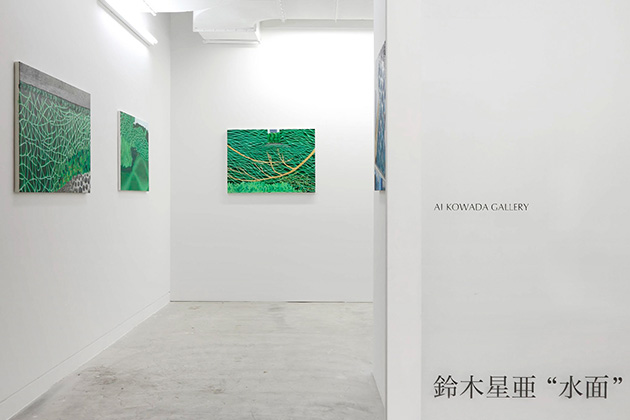
"The Surface of the Water 15_01 " oil on canvas 194.0 x 260.6cm 2015
©the artist courtesy of Ai Kowada Gallery
Ai Kowada Gallery is pleased to present some recent works by Seia Suzuki in its newly opened gallery in room #211 in 3331 Arts Chiyoda.
Suzuki has achieved a solid reputation as a painter because of his landscapes of skewed perspectives which are composed of commonplac elements such as houses,
foliage and roads rendered in naïve art like style. He received a VOCA Prize in 2012 and had solo shows in the Dai-ichi Life Gallery and Tokyo Opera City Art Gallery in 2015, which were well received by the public.
In creating his personal style he has developed a singular way of working based on the method of text-sketching; that is he records the impression he receives from the scenery that he intends to paint on the site and then work in the studio to paint the picture. Although methodically quite peculiar, Suzuki believes that reliance on recorded words rather than on visual records such as drawings or photos can help him transplant onto canvas the various sensations that he received from the actual scenery better. Such an approach also seems to agree with Suzuki's determination to create paintings based on perception freed from all the pictorial conventions that artists are prone to comply with at a subconscious level.
The show will feature the artist's recent paintings and drawings depicting water surfaces (one of the recurrent subjects in his works.)
Reflecting on his choice of this theme, the artist commented; "The choice of water surfaces as a subject has not been a conscious one for me. However, I may be attracted to it because it vividly gives me an idea about how all things are". Here, the artist seems to parallel water and the state of our world as both being formally indefinite and reflecting all of its changing environments.
'The world a painting sees' is Suzuki's own saying. According to the artist, the phrase shows his understanding that often the elements in a painting are there not by a painter's active will but by the formal requirements of the medium of the painting. Thus the artist considers that the painting itself has selective eyes to decide on the elements to be included in a picture.
Borne out of the conflict between the artist's struggle for perceptual freedom and his inevitable compliance to the pictorial requirements,
the images of the fluid water surface would lead the viewers into the untrodden area in the realm of art appreciation.
INSTALLATION VIEW

